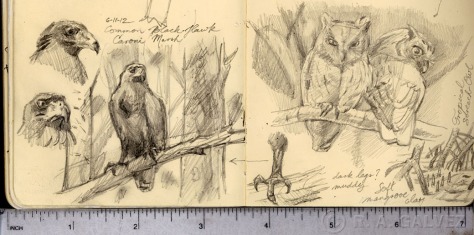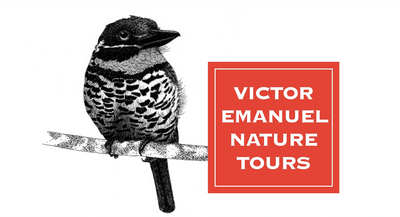Here are some sketches from my June of 2012 trip to Trinidad & Tobago. Below is the lower portion of a spread done at the Caroni Swamp in northeastern Trinidad. To the left is a Common Black Hawk (Buteogallus anthracinus) and to the right a pair of Tropical Screech-Owls (Megascops choliba).
I lugged around nice paper, watercolors and favorite pads, but 80% of the sketches I did were pencil thumbnails on a 3.5” x 5.5” Moleskine originally meant for notes. Since it had been raining most of the trip, I found it more prudent to quickly pull out this pad from my pocket and sketch. It was a run and gun trip – mostly a birdwatching group and they liked a quick pace.
Dark Legs on a Common Black Hawk?
Everyone knows that Common Black Hawks – and all Buteogallus sp. – have yellow legs. Well how did I wind up with dark legs in my sketches?
It turns out I captured the mud-caked legs of a bird, which appeared naturally dark at first. Common Black Hawks that live in mangrove habitats will often walk over the mud, foraging for crabs or fish stranded by the tides. And anyone who’s ever walked on mangrove shallows knows how soft this clay can be. In South Florida, I’ve often seen egrets, spoonbills and shorebirds with dark legs as a result of walking on this clay.
I often wonder whether I capture any information of value in my sketches. Photographs can hold so much detail that one often discovers minutia in them that wasn’t necessarily noticeable in the field. Not to mention the speed of it compared to sketching.
We were cruising on a flats boat through the Caroni Swamp when this Common Black Hawk was discovered, perched on the branches of a Red Mangrove. We must have spent no more than five minutes on this bird, as it flew from one perch to another. It is rare that I have the luxury of pulling out the desired paper and watercolors while the bird is posing for me.
The screech-owls were deep in the mangroves along the path leading to the boat ramp. I was still trying to sketch the forms of nearby Red-capped Cardinals when the owls were announced. It seemed as if the photographers in our group were challenged by branch obstructions – yet I don’t doubt that some phenomenal photos resulted from this. I must have spent no more than eight minutes on this sketch. Sure, it does not hold enough information for me to derive a complete painting from it, but combined with future sketches, I might have enough to compose something worthy.
Often, sketches are no more than quick lines. In them, I try to capture jizz and form first. If I don’t have the right shapes to begin with, it won’t matter how much detail I add. The image will only be a stylization. We spent no more than 15 minutes at the overlook from Little Tobago Island, from where we watched Red-billed Tropicbirds, Red-footed and Brown Boobies fly by.
All these sketches were done while observing birds in the field using Leica Ultravid 8×32 HD binoculars. Their compact and lightweight build are perfect for holding with one hand while sketching with the other. The short length of their barrels allows for excellent bright and crisp images, which compensate for less magnification.
This article was originally posted in the Florida Keys Hawkwatch blog on July 23, 2012.
TRINIDAD: NATURE & WILDLIFE ART WORKSHOP
FEBRUARY 23 – MARCH 1, 2017
To find our more about tours led by Rafael Galvez visit the
Victor Emanuel Nature Tours website.




